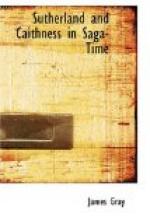In these brochs the farmer lived, and his women-kind span and wove and plied their querns or hand-mills, and, in raids, they shut themselves up, and possibly some of their poorer neighbours took refuge in the brochs, deserting their huts and crowding into the broch; but of this practice there is no evidence, and the nearest hut-circles are often far from the remains of any broch.
For defence the broch was as nearly as possible perfect against any engines or weapons then available for attacking it; and we may note that it existed in Scotland and mainly in the north and west of it, and nowhere else in the world.[8] It was a roofless block-house, aptly described by Dr. Joseph Anderson as a “safe.” It could not be battered down or set on fire, and if an enemy got inside it, he would find himself in a sort of trap surrounded by the defenders of the broch, and a mark for their missiles. The broch, too, was quite distinct from the lofty, narrow ecclesiastical round tower, of which examples still are found in Ireland, and in Scotland at Brechin and Abernethy.
To resist invasion the Picts would be armed with spears, short swords and dirks, but, save perhaps a targe, were without defensive body armour, which they scorned to use in battle, preferring to fight stripped. They belonged to septs and clans, and each sept would have its Maor, and each clan or province its Maormor[9] or big chief, succession being derived through females, a custom which no doubt originated in remote pre-Christian ages when the paternity of children was uncertain.
Being Celts, the Picts would shun the open sea. They feared it, for they had no chance on it, as their vessels were often merely hides stretched on wattles, resembling enlarged coracles. Yet with such rude ships as they had, they reached Orkney, Shetland, the Faroes and Iceland as hermits or missionaries.[10] In Norse times they never had the mastery of the sea, and the Pictish navy is a myth of earlier days.[11]
Lastly, as we have seen, the Picts of Cat had never been conquered, nor had their land ever been occupied by the legions of Rome, which had stopped at the furthest in Moray; and the sole traces of Rome in Cat are, as stated, two plates of hammered brass found in a Sutherland broch, and some Samian ware. Further, Christian though he had been long before Viking times, the Pict of Cat derived his Christianity at first and chiefly from the Pictish missions, and later from the Columban Church, both without reference to Papal Rome; and his missionaries not only settled on islands off his coasts, but later on worshipped in his small churches on the mainland; and many a Pictish saint of holy life was held in reverence there.




